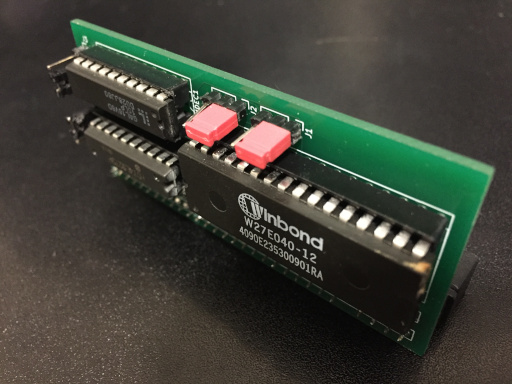

Observe the fact the edge connector sticks out of the reverse side of the circuit board.
The card will accept the following ROM sizes, as controlled by the red jumpers J1 and J2 :-
I used to KiCad to prepare this
circuit diagram.
When placed and routed, and then the board manufactured and populated,
you get :-
Observe the fact the edge connector sticks out of the reverse side of the
circuit board.
The card will accept the following ROM sizes,
as controlled by the red jumpers J1 and J2 :-


| Chip | Size | Subpages per slot | J1 | J2 | Comments |
|---|---|---|---|---|---|
| 27C512 | 64KB | 4 | 5V | any | Place chip so that pins 1,2,31,32 are empty |
| 27C010 | 128KB | 8 | any | 5V | |
| 27C020 | 256KB | 16 | SP3 | 5V | |
| 27C040 or 27E040 | 512KB | 32 | SP3 | SP4 |
The card provides ROM for two adjacent ROM slots, as controlled by the black jumpers J3 and J4 :-
| Slots | J3 | J4 | Comments |
|---|---|---|---|
| 0 and 1 | 0V | 0V | Don't use this combination, the system ROMs are in these slots |
| 2 and 3 | 0V | 5V | ROM cards normally sat in slot 2, older SDX ROMs sat in slot 3 |
| 4 and 5 | 5V | 0V | Boot ROM and SDX ROMs normally sat in these slots |
| 6 and 7 | 5V | 5V | I've never seen anything in slot 6, slot 7 was intended for games |
The content of the ROM chip can be viewed as a sequence of 8KB chunks, which appear in this order :-
Note that the
.COM to ROM
program can be used to make ROM image files for programming into this
"dual ROM slot" board.
Be sure to use LOADER2.BIN or LOADER2A.BIN.
Also note that the Disk to ROM program can be used to convert CP/M filesystem images into ROM Disc Images. You can combine suitable CP/M boot ROM and SDX BASIC ROM images with these ROM Disc Images to produce a system which can access ROM content as disk, from both CP/M and SDX BASIC.
The board in the photo has the J1 and J2 red jumpers set for a 27E040, and the J3 and J4 black jumpers set for ROM slot 4 and 5.
The circuit uses a GAL16V8 to decode when the ROM slots are accessed and when the subpage register is written, and a 74LS273 to act as the subpage register.
These are many possible uses :-
The ROM card is plugged in to the left-hand-side edge connector. This obviously means you can't use an SDX or REMEMOrizer at the same time, although if you had a REMEMOrizer, you probably wouldn't need a ROM card.
If you shop around :-
| Item | Cost |
|---|---|
| PCB | £2 |
| ROM | £3 |
| GAL16V8 | £1 |
| MTX edge-connector | £2 |
| Passives, headers, sockets, etc... | £2 |
| Total | £10 |
I sometimes have spares on my shelf, which I sell for £10. Email me if you're interested.
Full package downloadable from here.